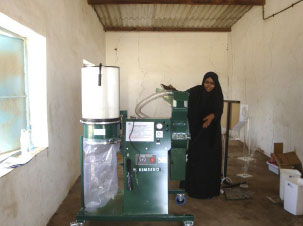July 2013
Source: SeedInfo 45, Offcial Newsletter of the WANA Seed Network
ICARDA, through its Arabian Peninsula Regional Program (APRP), initiated an extensive research and technology transfer program to identify and promote local production and use of indigenous forage species for feed production and range rehabilitation. The goals are to save the scarce water resources in the region, minimize soil degradation, and conserve and use local plant flora and biodiversity. ICARDA implemented the project ‘Technology Transfer to Enhance Rural Livelihoods and Natural Resource Management’ in close cooperation with the national agriculture research and extension systems in the countries of the AP. The International Fund for Agricultural Development supports the project.
Seed multiplication and distribution of improved indigenous forage species are major components of the project. It is planned to establish Seed Technology Units (STUs) in the United Arab Emirates, Oman, Saudi Arabia, Qatar, and Yemen. The STUs will make the seed of targeted species available through improved crop management practices, appropriate postharvest technologies, and extensive capacity building.
The project provided seed processing facilities, technical backstopping, and training. Five staff members of the National Center for Livestock Research, located in Lahaj, participated in the practical sessions on the assembly, testing, and demonstrations of the seed threshing and cleaning machinery provided by the project.
In Yemen, the STU was establsihed in Lahj. The project provided the following machines:
- Kimseed Multi Seed Thresher CW08 – comprising threshing, pre-cleaning and aspiration facilities – which is used for a wide range of field, forage, and pasture crops
- Kimseed Seed Cleaner MK3 – comprising screens and aspiration system – which is used for the fine cleaning of a wide range field, pasture, and forage crops
- Vacuum Separator – comprising a Multiseed Venturi with Flow Attachment – for the precision cleaning and grading of seed into different categories based on specific weight
- Hand held screens – comprising a set of manual screens stacked on top of each other – which make it easy to clean seeds.

Hands-on practical training with Kim Seed Cleaner
During the training session, the participants were taught how to assemble the components of each machine. They then tested them in threshing, cleaning, and grading the seeds of
Cenchrus ciliaris and fodder sorghum, following a learning-by-doing approach.
STUs require seed quality control amenities to complement these facilities. After processing, information on the physical purity, moisture content, viability, and germination precentage of
the seed will be needed. A general purpose laboratory with a germinator, benches, analytical balance, petri dishes, and filter paper are available in the National Center for Livestock and can be used for quality control purposes. However, a short term training is needed to provide the STU staff with the necessary seed testing skills.
By Abdoul Aziz Niane, ICARDA, P.O. Box 5466, Beirut, Lebanon; E-mail: a.niane@cgiar.org